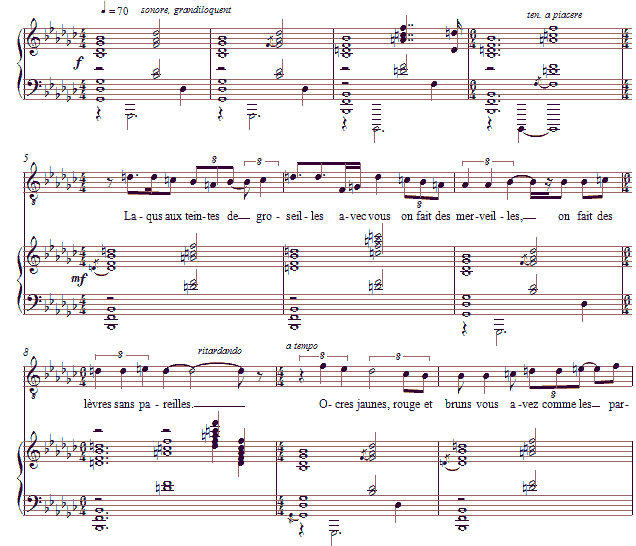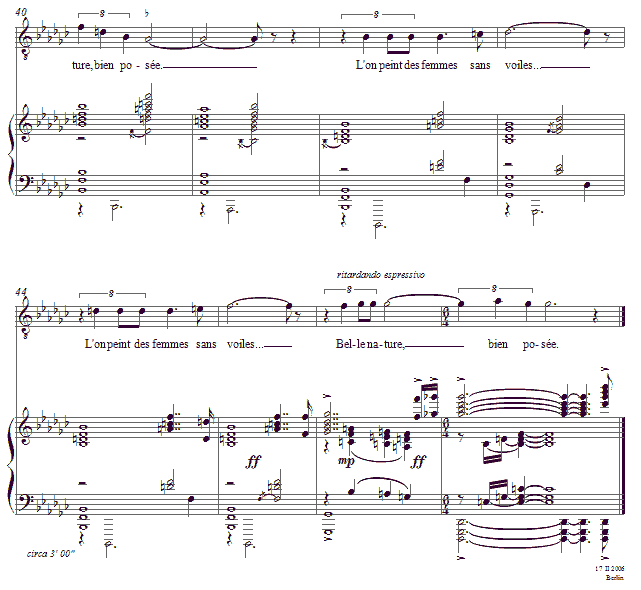Music and Texts of GARY BACHLUND
Vocal Music | Piano | Organ | Chamber Music | Orchestral | Articles and Commentary | Poems and Stories | Miscellany | FAQs
Chanson des peintres - (2006)
Charles Cros
for tenor and piano
pour Monsieur Guy Gabelle
Laques aux teintes de groseilles
Avec vous on fait des merveilles,
On fait des lèvres sans pareilles.
Ocres jaunes, rouges et bruns
Vous avez comme les parfums
Et les tons des pays défunts.
Toi, blanc de céruse moderne
Sur la toile tu luis, lanterne
Chassant la nuit et l'ennui terne.
Outremers, Cobalts, Vermillons,
Cadmium qui vaux des millions,
De vous nous nous émerveillons.
Et l'on met tout ça sur des toiles
Et l'on peint des femmes sans voiles
Et le soleil et les étoiles.
Et l'on gagne très peu d'argent,
L'acheteur en ce temps changeant
N'étant pas très intelligent.
Qu'importe ! on vit de la rosée,
En te surprenant irisée,
Belle nature, bien posée.[ 4 pages, circa 3' 00" ]
Charles Cros
Charles Cros (1842-1888) was a French poet and inventor. Passionate about both literature and science, he spent time between 1860 and 1863 as a professor of chemistry at the Institut parisien des Sourds-Muets. In 1869, he presented to the "Société française de photographie" a three-color photographic process. He also worked on advancing telegraph technology, and presented for the Exposition of 1867 a prototype of an automatic telegraph. In 1887, he formulated the principle for a mechanism of sound recording, presenting a paper before the Académie des Science, proposing that sound vibrations be engraved on metal through a stylus attached to a vibrating membrane.
As a poet, his inspirations was in part Surrealism, but as a poet he was relatively ignored by his own epoque. Among his published works are Le Coffret de santal (1873 and added to in 1879), Le Fleuve (1874), La Vision du Grand Canal des Deux Mers (1888) and Le Collier de griffes (1908), published posthumously.
The above poem continues on in one version with the following strophes, which I chose not to include in the song setting:
Pluriel féminin
Je suis encombré des amours perdues,
Je suis effaré des amours offertes.
Vous voici pointer, jeunes feuilles vertes.
Il faut vous payer, noces qui sont dues.
La neige descend, plumes assidues.
Hiver en retard, tu me déconcertes.
Froideur des amis, tu m'étonnes, certes.
Et mes routes sont désertes, ardues.
Amours neuves, et vous amours passées,
Vous vous emmêlez trop dans mes pensées
En des discordances éoliennes.
Printemps, viens donc vite et de tes poussées
D'un balai d'églantines insensées
Chasse de mon coeur les amours anciennes!The strophes for this song refer to painting, to the colors by their names and by their "chemistry" as well, as Cros celebrates the technique of painting itself, by which "one may put all on canvases, and paint women without veils and the sun and the stars." Below follows an English interpretation of the verses which I chose to set.
Lacquers tinted with red currant
With you one can do wonders,
One can make lips without parallel.
Yellow ochre, red and brown
You are like perfumes
And the sounds of the far-off country.
You, modern lead white
On the canvas, you gleam, a lantern
Dispelling night and lackluster boredom.
Ultramarines, cobalts, vermillions.
Cadmiums which multiply colors
By which you fill us with wonder.
And one may put all on canvases,
And paint women without veils
And the sun and the stars.
And one may win a little money,
The buyer in this time changes,
And isn't too savvy.
What does it matter? One sees the dew,
And the supreme iridescence,
Lovely nature, well composed.
The back-and-forth between G-flat major and B-flat major perhaps feels like a progression towards the second tonal region as the vocal line begins in B-flat. Yet the song ends in G-flat major. These are merely colors on the palette, as the artist celebrates them in of themselves as well as in juxtaposition, one to the other. The chord form throughout blends the each "tonic" with its own "dominant" in a stately and slow harmonic rhythm. The tessitura of the song is specific to a tenor, lying across the passagio for a dramatic climax.
The reverse "progression" from the opening cluttered in pleasant polytonal coloring ends the song setting, as the voice rises in operatic fashion to the highest point in its tessitura for the final statement -- an affirmation of "Lovely nature, well composed."
Guy Gabelle
Composed for French tenor Guy Gabelle, a tenor who has sung for many years in Liège, he was a most pleasant and supportive colleague during our performances of Zemlinsky's Der König Kandaules both at the Opera Royal de Wallonie and Opera Royal de Nancy et Lorraine. The opera world is made up of many of us performers less well known than the so-called stars and luminaries. Without the likes of Guy and thousands like him, casts would be empty of those singers and actors crucial to the collaborative success of any production.
The score is available as a free PDF download, though any major commercial performance or recording of the work is prohibited without prior arrangement with the composer. Click on the graphic below for this piano-vocal score.




